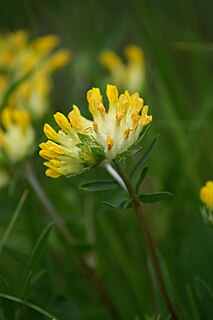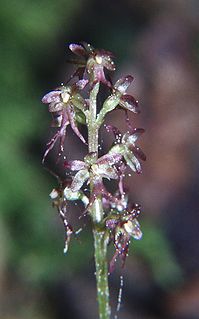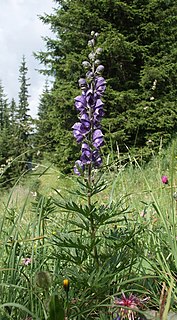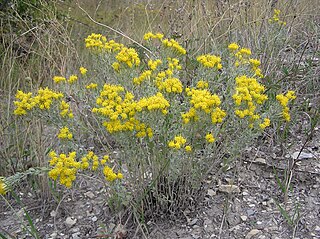
Bellis is a genus of flowering plants in the family Asteraceae.

Genista is a genus of flowering plants in the legume family Fabaceae, native to open habitats such as moorland and pasture in Europe and western Asia. They include species commonly called broom, though the term may also refer to other genera, including Cytisus and Chamaecytisus. Brooms in other genera are sometimes considered synonymous with Genista: Echinospartum, Retama, Spartium, Stauracanthus, and Ulex.

Heracleum is a genus of biennial and perennial herbs in the carrot family Apiaceae. They are found throughout the temperate northern hemisphere and in high mountains as far south as Ethiopia. Common names for the genus or its species include hogweed and cow parsnip.

Verbascum is a genus of over 450 species of flowering plants, common name mullein, in the figwort family Scrophulariaceae. They are native to Europe and Asia, with the highest species diversity in the Mediterranean.

Reseda, also known as the mignonette, is a genus of fragrant herbaceous plants native to Europe, southwest Asia and North Africa, from the Canary Islands and Iberia east to northwest India. The genus includes herbaceous annual, biennial and perennial species 40–130 cm tall. The leaves form a basal rosette at ground level, and then spirally arranged up the stem; they can be entire, toothed or pinnate, and range from 1–15 cm long. The flowers are produced in a slender spike, each flower small, white, yellow, orange, or green, with four to six petals. The fruit is a small dry capsule containing several seeds.

Bellis perennis, the daisy, is a European species of the family Asteraceae, often considered the archetypal species of the name daisy. To distinguish this species from other plants known as daisies, it is sometimes qualified as common daisy, lawn daisy or English daisy. Historically, it has also been widely known as bruisewort, and occasionally woundwort.

Malva is a genus of herbaceous annual, biennial, and perennial plants in the family Malvaceae. It is one of several closely related genera in the family to bear the common English name mallow. The genus is widespread throughout the temperate, subtropical and tropical regions of Africa, Asia and Europe.

Inula is a large genus of about 90 species of flowering plants in the family Asteraceae, native to Europe, Asia and Africa.

Epilobium is a genus of flowering plants in the family Onagraceae, containing about 197 species. The genus has a worldwide distribution. It is most prevalent in the subarctic, temperate and subantarctic regions, whereas in the subtropics and tropics Epilobium species are restricted to the cool montane biomes, such as the New Guinea Highlands.

Isatis is a genus of flowering plants in the family Brassicaceae, native to the Mediterranean region east to central Asia. The genus includes woad. Due to their extremely variable morphology, the Asian species in particular are difficult to determine; the only reliable diagnostic feature is the ripe fruit. They are (usually) biennial or perennial herbaceous plants, often bluish and hairless or downy hairy with the upright stem branched.

Anthyllis is a genus of flowering plants in the family Fabaceae. This genus contains both herbaceous and shrubby species and is distributed in Europe, the Middle East and North Africa. The most widespread and familiar species is A. vulneraria, a familiar grassland flower which has also been introduced to New Zealand.

Jacobaea is a genus of flowering plants in the tribe Senecioneae and the family Asteraceae. Its members used to be placed in the genus Senecio, but have been separated into the segregate genus Jacobaea on the basis of molecular phylogenetics in order to maintain genera that are monophyletic.

Anemonoides is a genus of flowering plants in the buttercup family Ranunculaceae. Plants of the genus are native to the temperate regions of the Northern Hemisphere, on the continents of North America, Europe, and Asia. The generic name Anemonoides means "anemone-like",, a reminder that many of the species were formerly included within the genus Anemone.

Neottia is a genus of orchids. The genus now includes the former genus Listera, commonly known as twayblades referring to the single pair of opposite leaves at the base of the flowering stem. The genus is native to temperate, subarctic and arctic regions across most of Europe, northern Asia, and North America, with a few species extending into subtropical regions in the Mediterranean, Indochina, the southeastern United States, etc.

The term bane, in botany, is an archaic element in the common names of plants known to be toxic or poisonous.

Asphodeline is a genus of perennial plants in the family Asphodelaceae, first described as a genus in 1830. It is native to the eastern Mediterranean region and the Middle East from Italy and Algeria east to Iran.

Galatella is a genus of flowering plants in the family Asteraceae, native to Europe, Asia, and northern Africa.

Doronicum pardaliances, known as leopard's-bane, is a species of flowering plant in the family Asteraceae. Like other members of the genus Doronicum, it is a rhizomatous herbaceous perennial. It has upright stems growing to 80 cm (31 in), with heart-shaped basal leaves and yellow flowers, generally 3–4 cm (1.2–1.6 in) across. It is native to western Europe and was introduced to the British Isles, where it was first recorded in Northumberland in 1633.

Goniolimon, sometimes called the statices, are a genus of flowering plants in the leadwort and plumbago family Plumbaginaceae, native to northern Africa, southern Europe, western and central Asia, Siberia, Mongolia and China. Low-lying perennial shrubs, some species are cultivated as ground covers.



















